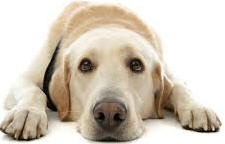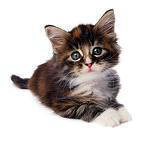|
One
of your most important responsibilities as a cat owner is to provide
your cat with the necessary nutrients required for its growth and
maintenance. Cats need a diet that contains protein, fat, minerals,
vitamins, and water. Those nutrients are the building blocks of various
structural body tissues; are essential for chemical reactions
(metabolism, catabolism); transport substances into, around, and out of
the body; supply energy for growth and maintenance; and provide
palatability. Basic minimum nutritional requirements for cats have been
established by the Feline Nutrition Expert (FNE) subcommittee of the
Association of American Feed Control Officials (AAFCO). Pet-food
manufacturers use those standards when producing cat foods.
Types of Cat Foods
Commercial cat foods are formulated as dry, semimoist, and canned.
The products differ in water content, protein level, caloric
density, palatability and digestibility. The differences are
primarily attributed to the processing methods used by pet-food
manufacturers. A quality cat food provides the necessary nutrients
in a properly balanced proprotion.
-
DRY FOODS
Dry foods contain 6 percent to 10 percent moisture. Cereals, grain
by-products, bone meal, fish meal, milk products, and vitamin and
mineral supplements are combined, extruded and dried into bite-sized
pieces. The pieces are then covered with flavor enhancers, such as
digest or animal fat, giving the product increased palatability. It
takes less dry food on an as-is basis than other types of food to
satisfy a cat, because dry food has more dry matter and a higher
energy content per gram fed. The primary advantages of dry cat food
are lower cost and convenience in allowing "free choice" feeding.
Generally, dry foods may be less palatable to a cat and have a lower
digestibility than the moister types. However, premium dry cat foods
are comparable in digestibility to grocery store brands of canned
cat foods, and can exceed lower quality canned cat foods.
-
SEMIMOIST FOODS
Semimoist cat food may be more appealing to some cats than dry cat
food. Moisture content is approximately 35 percent. However, after
the package is opened, palatability decreases and spoilage increases
because of dehydration. These foods can also be fed free choice. The
cost is mid-range, between that of dry and canned food. Semimoist
food resembles ground- or whole-meat tidbits. Meat and meat
byproducts are the primary ingredients. They are combined with
soybean meal, cereals, grain byproducts, and preservatives.
Manufacturers add organic acids (phosphoric, hydrochloric and malic
acids) and sorbitol and dextrose to prevent spoilage and retain
moisture in semimoist cat foods.
-
CANNED FOODS
Canned cat food is quite popular with owners, despite its higher
cost. Canned varieties are highly palatable to cats, which can be
helpful if your cat is a finicky eater. Canned cat food has a water
content of a least 75 percent, so it is a good dietary source of
water. When unopened it has the longest shelf life. Canned food is
available in ration sizes (12 to 22 ounce cans) or gourmet sizes (3
to 6 ounce cans). Gourmet canned cat foods generally feature organ
meats (e.g., kidney, liver) as their primary food ingredient.
Because some brands may be nutritionally incomplete, it is
particularly important to read the nutrition labels carefully on
such specialty cat-food items. Gourmet canned foods may induce food
consumption in anorexic cats or meet increased protein requirements
that occur during wound healing or with protein-losing diseases.
Return to Top
Selecting Cat Food
Reading the nutrition label on the packages is the best way to compare
cat foods. Pet-food manufacturers are required to supply certain
nutrition information on the package. Labeling regulations are
established by the AAFCO and the United States Food and Drug
Administration (USFDA) to ensure compliance with federal and state feed
regulations. The section labeled "guaranteed analysis" lists the
percentages of protein, water, fat, fiber, and ash. The minimum amounts
of crude protein and fat and the maximum amounts of crude fiber and
sometimes ash, and water must be listed on the label. Although this
information is required, it is of little value since it does not
represent the actual amounts of those nutrients present in the product,
only minimum and maximum amounts.
In 1993, the AAFCO
approved the discretionary listing of a cat food's caloric content on
the label. Pet food manufacturers determine the caloric content of their
product by using a standard nutrition formula based on metabolized
energy per gram from protein, fat, and carbohydrates. A food's caloric
content will help cat owners in determining how much to feed their cats.
Basically, the average adult cat needs about 30 kilocalories per pound
of body weight per day. Individual needs may differ from that average
according to age, environment, and activity level. The ingredients list
includes all items used in the product, including flavor enhancers,
artificial colors and preservatives. The items are listed in decreasing
order by weight. Meat, meat by-products, or seafood should be listed
among the first few items; that indicates that the product probably
contains enough animal-source ingredients to supply taurine and
essential fatty acids. Also, be sure that niacin and vitamin A have been
added, since those vitamins are sensitive to food-processing methods.
The nutritional claim states the stage of a cat's life cycle for which
the food is a complete and balanced product (e.g., growth, maintenance,
pregnancy). It should also state that it meets the requirements of the
AAFCO, preferably by animal-feeding trials. Feeding a cat a product that
does not have a nutritional claim on the label cannot guarantee a
complete and balanced diet for the animal. Feeding directions are
usually provided on the label. This provides a guideline for owners on
quantity and timing of feedings. However, owners need to adjust feeding
portions to keep their cat at the ideal body weight.
Return to Top
Homemade Diets
Formulating your own cat food is a difficult and time consuming process.
Also, the nutrients in the formula may not be available in the right
quantities and proportions to be beneficial to your cat. Therefore, it
is usually recommended that the cat owner use a commercial,
nutritionally balanced product, unless a veterinarian recommends a
recipe for a home-formulated ration.
Basic Guidelines on
Feeding Cats
Environmental conditions can affect a cat's eating habits. For
example, heavily trafficked areas, noise, the presence of other
animals, dirty food containers, or nearby litter boxes can deter a
cat from eating. Therefore, try to be sensitive to your cat's eating
behavior and make necessary adjustments for optimum feeding
conditions.
The amount fed is based on caloric content, quality of nutrients,
and the cat's special dietary needs. Meat scraps from the table and
specialty cat treats can be fed from time to time but should not be
a steady diet for your cat. Those treats often lack the proper
proportion of basic nutrients a cat requires to maintain its health.
A rule of thumb is not to let treats exceed 10 to 15 percent of the
cat's daily diet. Although raw meat is an excellent source of many
nutrients, it is not recommended as food for cats, because it is a
potential vehicle for toxoplasmosis. Also, salmonellosis can occur
from contaminated meat and spoiled meat harbors various bacteria
that can upset the digestive system.
- VARIETY
Feeding your cat two or three different cat foods provides flavor
variety. It also prevents the cat from developing a preference for a
food that may not be 100 percent nutritionally balanced. However, if
your cat is already a finicky eater that craves an unbalanced diet,
you can break the habit. A good method is to convert it to a new
taste slowly by mixing the new food with the old. Increase the
amount of new to old food by one-quarter increments (i.e., 1:4, 2:4,
3:4) until your cat accepts the new food. However, if your cat is
content with a single nutritionally complete and balanced cat food,
there really is no reason to change its preference.
-
VITAMIN AND MINERAL
SUPPLEMENTS
A cat food that meets or exceeds the FNE subcommittee's nutrition
standards assures an adequate supply of vitamins and minerals in the
diet. Therefore, the use of vitamin and mineral supplements,
including brewer's yeast, is unnecessary. The addition of a
supplement without a veterinarian's approval may actually harm your
cat.
-
FOOD STORAGE
Refrigerate any unused portion of canned cat food, to maintain
quality and prevent spoilage until the next feeding. To prevent
possible digestion problems related to temperature differences,
refrigerated food should be brought to room temperature before it is
offered to your cat. Canned rations can be divided into two servings
per day. Store unused portions of dry cat food in a cool, dry
location, and use all the food within six months of purchase.
Lengthy storage decreases the activity and potency of many vitamins.
Storing dry cat food in an airtight container will prevent further
nutrient deterioration and help maintain palatability.
Return to Top
Dietary Considerations
Feline Lower
Urinary Tract Disease (FLUTD)
Various studies have provided new dietary considerations when
feeding a cat that has had
FLUTD. The pH of the urine influences the formation of
certain specific crystals. Struvite crystals rarely form in urine
with a pH of less than 6.4, whereas they often appear when the urine
pH rises to above 7.0. Diet influences urinary pH. For example, when
dry food is available to a cat "free choice," the cat's urine pH
decreases.
Current feeding
recommendations for FLUTD cats are as follows:
-
Feed diets that
ensure adequate acidification. However, do not add urine
acidifiers to diets that are already acidic. Overacidification
can cause metabolic acidosis, resulting in impaired kidney
function and mineral imbalance that includes potassium
depletion. Also, urine that is too acidic provides a good
environment for another mineral deposit (oxalate crystals) to
form which can also cause urinary obstruction.
-
Provide fresh
water at all times. The more that a cat drinks, the less chance
crystals and uroliths (small mineral stonelike deposits) will
form.
-
Restrict
dietary magnesium intake to 40 milligrams per 100 kilocalories
and phosphorus to 200 milligrams per 100 kilocalories if
adequate urine pH (6.4 or less) is maintained.
-
Feed small
meals on a frequent basis or feed free-choice dry foods.
Special
Nutritional Needs
Throughout a cat's life, there are stages in which the cat requires
different nutrients. Those include kittenhood, pregnancy, lactation,
and finally, old age. There are also special dietary needs
associated with certain nutrition-sensitive diseases (food
allergies) and chronic organ system diseases (kidney disease, liver
disease, congestive heart failure and diabetes)
Return to Top
Common Feeding Problems
|
Avoid these
common feeding
errors |
Overfeeding can lead to the number-one
nutritional disease, OBESITY. Excessive body weight can
increase the risk of liver disease, heart disease, respiratory
problems, and constipation. Furthermore, fat cats are at a
greater risk of developing diabetes and arthritis. Pet food
manufacturers have formulated diets that have fewer calories per
gram that may be helpful in treating obese cats.
Feeding dog food to cats is a common
error, especially if dogs and cats are in the same household.
Dog foods are developed for the nutritional needs of dogs, not
cats. There can be serious consequences if a cat's diet is
deficient in protein, taurine, niacin, vitamin A, and fatty
acids.
Overdosing with vitamin and mineral
supplements has been known to cause severe medical problems in
cats. Physiological imbalances caused by excess vitamins and
minerals can lead to the binding of other nutrients. Overdoses
of vitamins A and D are more common than deficiencies of those
vitamins, because of unnecessary supplementation of an already
balanced diet.
Exclusively feeding meat or fish
results in an unbalanced diet and causes related nutritional
diseases. Diets containing large quantities of fish can
cause yellow-fat disease (steatitis), a result of vitamin E
deficiency. Nutritional secondary hyperparathyroidism is usually
caused by all-meat homemade diets that are deficient in calcium,
thus creating a mineral imbalance in the calcium-phosphorus
ratio. The disease most commonly occurs in kittens that are
rapidly growing.
|
|


 KIHEI
PET SUPPLY
KIHEI
PET SUPPLY